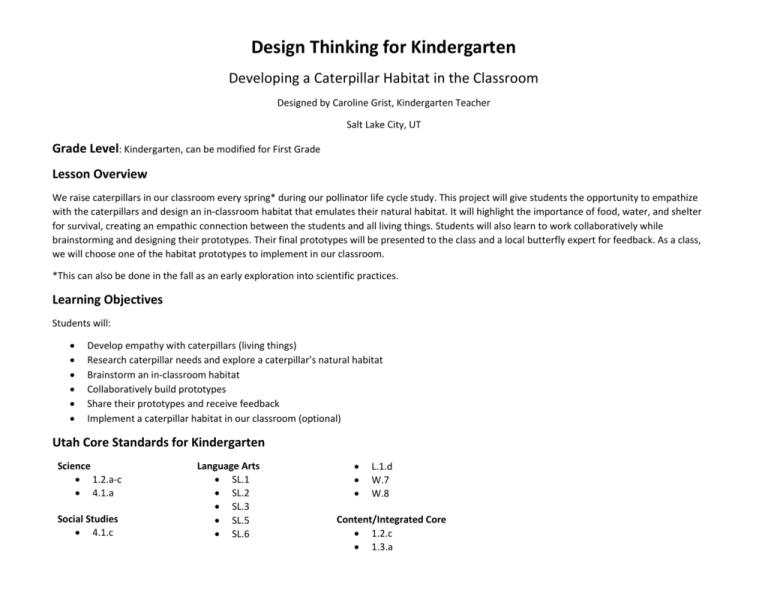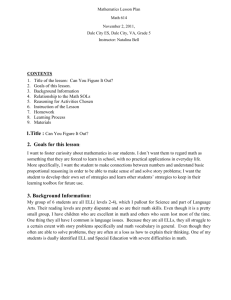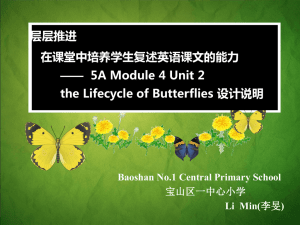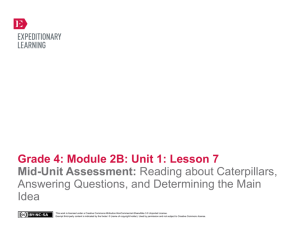Design Thinking for Kindergarten
advertisement

Design Thinking for Kindergarten Developing a Caterpillar Habitat in the Classroom Designed by Caroline Grist, Kindergarten Teacher Salt Lake City, UT Grade Level: Kindergarten, can be modified for First Grade Lesson Overview We raise caterpillars in our classroom every spring* during our pollinator life cycle study. This project will give students the opportunity to empathize with the caterpillars and design an in-classroom habitat that emulates their natural habitat. It will highlight the importance of food, water, and shelter for survival, creating an empathic connection between the students and all living things. Students will also learn to work collaboratively while brainstorming and designing their prototypes. Their final prototypes will be presented to the class and a local butterfly expert for feedback. As a class, we will choose one of the habitat prototypes to implement in our classroom. *This can also be done in the fall as an early exploration into scientific practices. Learning Objectives Students will: Develop empathy with caterpillars (living things) Research caterpillar needs and explore a caterpillar’s natural habitat Brainstorm an in-classroom habitat Collaboratively build prototypes Share their prototypes and receive feedback Implement a caterpillar habitat in our classroom (optional) Utah Core Standards for Kindergarten Science 1.2.a-c 4.1.a Social Studies 4.1.c Language Arts SL.1 SL.2 SL.3 SL.5 SL.6 L.1.d W.7 W.8 Content/Integrated Core 1.2.c 1.3.a Preparation Students should have some background knowledge about caterpillars and butterflies before this lesson. o Life Cycle o Basic survival needs of a specific caterpillar (Ex. Painted Lady or Monarch) Food (ex. Thistles/Mallow or Milkweed, respectively) Water Shelter/Safety Determine a good place around your school to observe caterpillars Contact a local pollinator or butterfly expert/enthusiast. These can often be found through one of the following: o Natural History museums o Community gardens o College horticulture, entomology, or biology departments o Local Lepidopterists' Society chapter o State extension agencies Materials Early instar larvae – Buy or find these before the start of this project. Front load/explore information about the specific caterpillar you will be using. Jar (or the container they arrived in) Chart Paper Markers Clipboards Pencils/crayons Camera Access to a computer/projector Prototype material possibilities: o boxes o construction paper o straws o glue o pipe cleaners o scissors o popsicle sticks o tape o markers/crayons o playdough or clay o packing materials o paper towel rolls Caterpillar habitat expert (see above) o This is optional. You can have your class be the experts, but an outside expert or user group gives more purpose to the project. If you choose to implement the project in your classroom: Tank/habitat container as determined by students Appropriate food source – this may need to be collected on a continuing basis throughout caterpillar growth All other materials for the final habitat should be determined by your students (i.e. shelter, place to attach for chrysalis state, food for butterflies, etc.) Resources From Caterpillar to Butterfly by Deborah Heiligman Information for finding and raising caterpillars/butterflies: http://www.raisingbutterflies.org/ http://www.mybutterflyguide.com/Butterfly_Guide_Home_Page.html Monarch Butterfly information: http://www.learnaboutmonarchs.com/index.html Monarch Life Cycle video: http://www.youtube.com/watch?v=7AUeM8MbaIk Painted Lady Lifecycle video: http://www.youtube.com/watch?v=sR7SSKPAlew The Lepidopterists’ Society: http://www.lepsoc.org/education.php Activity Timeline **Students should have basic background knowledge about butterflies before this project begins. This could be broken into a morning/afternoon activity or over two days. Designate a spot in the classroom to hang up the posters. Activity Time Introduction 15 minutes Description Review a caterpillar’s survival needs – make a chart listing the needs and how the needs are met. Compare with students’ survival needs and coping mechanisms. Add to the chart and discuss similarities/differences between students and the caterpillars. See example below. Caterpillar’s needs Shelter Food How the needs are met Leaves/plants Leaves Students’ needs Shelter Food How the needs are met House/roof Bought at the store and cooked at home Water Water within leaves Water Safety Camouflage Dense leaves Bad taste Stay away from birds Sticks and leaves to climb up Safety Turn on the spigot and drink water from a cup A place to stay Family and friends Police and firefighters Don’t talk to strangers Playground Run outside Friends Climbing/Crawling Empathy: Initial observations and selfconnections 10 minutes Playing Introduce caterpillars in an empty jar and ask students to observe. They may share their observations with a neighbor. Remind students about the needs of the caterpillars. How are those needs being met? (Do they have food, water, shelter, and safety?) If students do not know what type of caterpillar it is and they have not been given sufficient background knowledge, they will need time to explore videos, books, life cycle stages, etc. about that particular caterpillar. Ask students to think of a time when they moved to a new home (or classroom). How did they make the new space “their own” so that it would meet their needs? Partner/whole group share. Introduce a thinking question: How can we, as a class, help meet the needs of these caterpillars? Write this question on a chart for students to think about. You will add to it later. Empathy: Research and Discovery 30 minutes Define the need/problem 20 minutes Take a walking field trip around the school. Students should take a clipboard, paper, and pencil/crayons to record observations through drawings. Allow students to explore plant life in order to find and observe caterpillars (and other insects). If there is a particular place that has an abundance of caterpillars, steer students that way. Take student directed pictures of any observations they may have. Return to the classroom. Synthesize information about habitat/needs gathered through observations, as well as background knowledge. Students should share and compare their observations with a neighbor, then share with the class. Make a poster of the observations. Create an Empathy Map as a class about what they observed in the jar and outside. Also incorporate background knowledge. See example below. Caterpillar Empathy Map Need Leaves to eat Leaves to drink fluid Leaves and sticks to climb on Leaves to hide in A place to change into a chrysalis Do Climb Crawl Spin webs/silk strands (some) Eat Stay still Hide Grow Change into chrysalis Fight with other caterpillars Think Find food and water Get away from the bird! I want to climb. It is time to change. Feel (inferred) Hungry Safe Scared Bored Tired Growing Crowded Happy/Satisfied Create a “User…needs a way to…because” statement based on Empathy Map. Keep it simple! You may choose to create a chart, but an easier way to frame it may be: “Describe who/what we are talking about.” “What do they need the most?” “Why do they need it?” Needs statement example: Growing caterpillars need a way to survive in our classroom because they will change into butterflies through metamorphosis. Another example: Small caterpillars need a place to eat and grow because they will become butterflies to pollinate the garden. Their needs statements can be more specific if they know more about the type of caterpillar for which they are designing a habitat. For example: Hungry Monarch caterpillars need a place to eat milkweed and grow because they will become butterflies and migrate South in the fall. **This is a good spot to break the lesson into two pieces. Brainstorm 20 minutes Review and discuss this question: How can we, as a class, help meet the needs of these caterpillars? Remind them about empathy, as discussed earlier. Create a checklist of requirements for each habitat. Post it for everyone to see while they are working. You could also type it up and give a copy to each group to check off while they work. Example: Our habitat has: Food/Water Shelter Safety Zones Chrysalis area Areas to crawl/climb Prototype 20-25 minutes Present However long it takes. Allot 3-5 minutes per presentation. Based on the needs statement and checklist, students will go to their seats and independently draw (brainstorm) their idea for a habitat. Students may then share with a partner/small group and then the whole class. It will be important to talk about how we need to listen to all ideas, even if we do not agree with them. This is a good time to teach social skills about listening and appreciating other perspectives. If you have room, post these around the classroom for kids to see and discuss. Divide students into small groups based on similar ideas to build their prototypes. Introduce prototype materials to the whole class. Put a box of materials at each work spot. Do not give them specific ideas for material uses. As they work, meet with each small group to guide them through their collaborative process. Remind students to reference the checklist. Encourage all kids to participate and be respectful of each other! Call your butterfly expert! After prototypes are completed, students will present their prototypes as a group. Students may practice first by presenting to the teacher or another adult. They should not make any changes at this time. Students will then present their prototypes to the class and the expert. Constructive feedback and questions are allowed. Students may need help understanding feedback is positive and helpful. It will also be important to guide students giving the constructive, helpful feedback. Prototype Updates 5-10 minutes After feedback, give students a very short time to process feedback as a group and make changes. Final presentations and concluding activity Depends on presentation style Students will then give final presentations. Options include: Exhibit set-up Whole group presentations Small group presentations (two groups present to each other then switch groups to present again) Present to “expert” Anything else your class might decide. Students may then choose one prototype to implement in the class and collaboratively build it. It may be necessary to discuss strategies to help students accept that their project was not chosen. It is equally important to discuss the successes of each project and the DT process. Assessment/Concluding Activity Ideally, students would actually create the habitat using appropriate materials and install it in the classroom for observation. If that is not an option, there are multiple ways to assess and conclude this project. Here are a few ideas: o o o Students will draw and write a short journal piece about their favorite part of the project. Students will share the most meaningful or successful part of the DT process with the class. Students will paint a picture of their ideal habitat, based on their prototypes.









